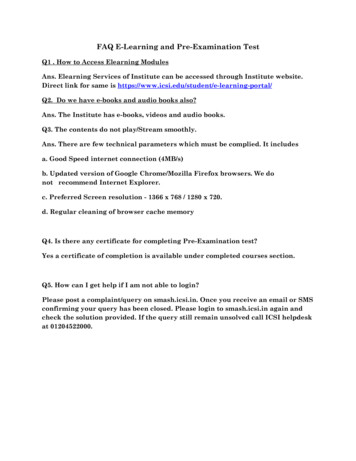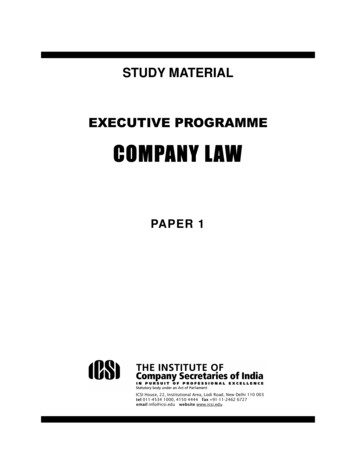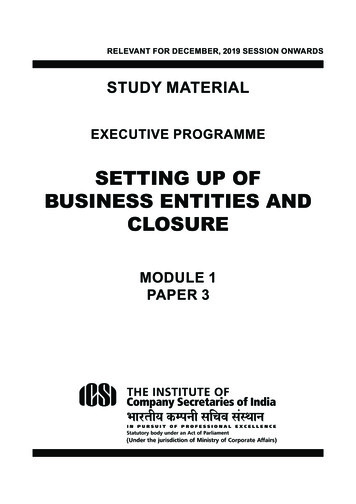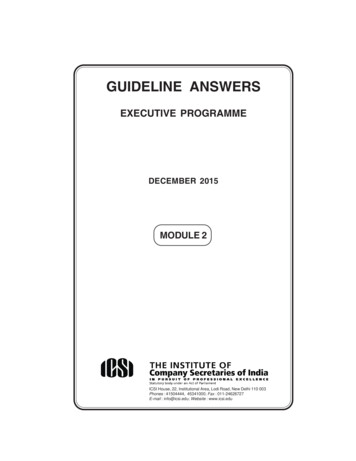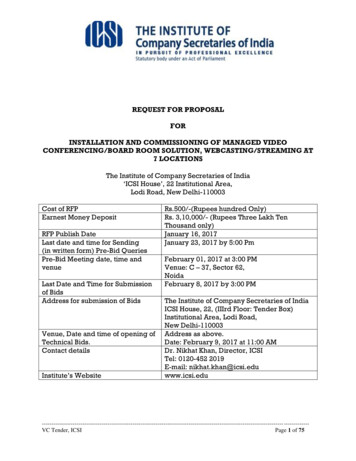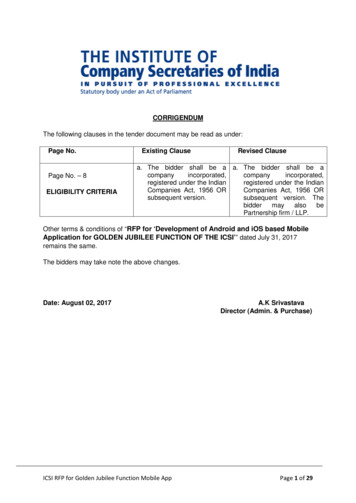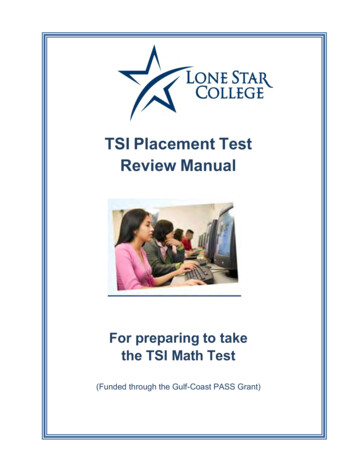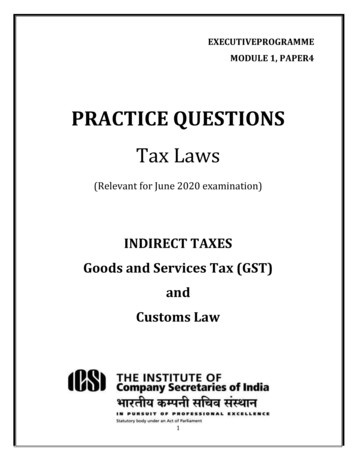
Transcription
EXECUTIVEPROGRAMMEMODULE 1, PAPER4PRACTICE QUESTIONSTax Laws(Relevant for June 2020 examination)INDIRECT TAXESGoods and Services Tax (GST)andCustoms Law1
April 2020 THE INSTITUTE OF COMPANY SECRETARIES OF INDIANo part of this publication may be translated or copied in any form or by any means without the priorwritten permission of The Institute of Company Secretaries of India.DISCLAIMER:The PRACTICE QUESTIONS have been prepared by competent persons and theInstitute hopes that it will facilitate the students in preparing for the Institute'sexaminations. It is, however, to be noted that the answers are to be treated as modelanswers and not as exhaustive and there can be alternative solutions available for thequestions. The Institute is not in any way responsible for the correctness or otherwiseof the answers. Students are expected to be well versed with the amendments in theLaws/ Rules made upto six months prior to the date of examination.2
CONTENTSS. No.Chapter No.SubjectPage No.Goods and Services Tax ‘GST’1Chapter 11Concept of Indirect Taxes at a glance42Chapter 12Basics of Goods and Services Tax ‘GST’103Chapter 13Concept of Time, Value & Place of Taxable Supply164Chapter 14Input Tax Credit & Computation of GST Liability235Chapter 15Procedural Compliance under GST336Chapter 16Basic Overview on Integrated Goods and Service Tax (IGST),44Union Territory Goods and Service Tax (UTGST), and GSTCompensation to StatesCustoms Act7Chapter 17Overview of Customs Act493
Chapter 11Concept of Indirect Taxes at a glanceBackground; Constitutional powers of taxation; Indirect taxes in India – An overview; PreGST tax structure and deficiencies; Administration of Indirect Taxation in India; Existingtax structure.Question 1What were the major deficiencies of VAT system in India?AnswerThe major deficiencies of VAT system in India were as under:(1)There was lack of uniformity in the rates of VAT in different States. Distortion occurson account of different rates of VAT, composition Scheme, exemptions, difference inclassification of goods, etc.(2)Central Sales Tax was not integrated with the State VAT. Therefore, it was difficult toput the purchases from other States at par with the purchases within the State.Consequently, the advantage of neutrality was confined only for purchases within theState.(3)For complying with the VAT provisions, the accounting cost increased which was notcommensurate with the benefit to traders and small firms.(4)VAT was paid at various stages and not at last stage. This had increased the requirementof working capital and the interest burden.(5)As a result of introduction of VAT, the administrative cost to the States had increasedon account of number of dealers going up significantly.Question 2What were the taxes which GST subsumed?AnswerGST subsumed the following:Central Taxes(a) Service tax;(b) Central excise duty;(c) Additional Duties of Excise (Goods of Special Importance);4
(d) Excise duty levied under the Medicinal and Toilet Preparations (Excise Duties) Act,1955;(e) Additional Duties of Excise (Textiles and Textile Products)(f) Additional customs duty (countervailing duty or CVD);(g) Special additional duty of customs (SAD);(h) Central surcharges and cesses.State Taxes(a) State VAT;(b) Central sales tax;(c) Entertainment tax not levied by local bodies;(d) Luxury tax;(e) Taxes on lottery, betting, and gambling;(f) Tax on advertisements;(g) State cesses and surcharges related to supply of goods and services;(h) Entry tax not levied by local bodies.(i) State Surcharges and Cesses so far as they relate to supply of goods and services(j) Purchase taxQuestion 3What were the highlights of Constitutional (101stAmendment) Act,2016 with respect to Goodsand Service Tax?AnswerHighlights of the Constitution (One Hundred and First Amendment) Act, 2016:The Constitution (One Hundred and First Amendment) Act, 2016 received the assent of thePresident on the 8thSeptember, 2016. Amendment of Constitution: The Bill amended the Constitution to introduce the goodsand services tax (GST). Consequently, the GST subsumed various central indirect taxesincluding the Central Excise Duty, Countervailing Duty, Service Tax, etc. It also subsumesstate value added tax, octroi and entry tax, luxury tax, etc. Concurrent powers for GST: The Bill insert a new Article in the Constitution to give thecentral and state governments the concurrent power to make laws on the taxation ofgoods and services.5
Integrated GST (IGST): Only the centre may levy and collect GST on supplies in thecourse of inter-state trade or commerce. The tax collected would be divided between thecentre and the states in a manner as prescribed by law, on the recommendations of theGST Council. GST Council: The President must constitute a Goods and Services Tax Council withinsixty days of this Act coming into force. The GST Council aim to develop a harmonizednational market of goods and services.The GST Council is to consist of the following three members:(i) the Union Finance Minister (as Chairman),(ii) the Union Minister of State in charge of Revenue or Finance, and(iii) the Minister in charge of Finance or Taxation or any other, nominated by eachstate government. Functions of the GST Council: These include making recommendations on:(i)taxes, cesses, and surcharges levied by the centre, states and local bodieswhich may be subsumed in the GST;(ii)goods and services which may be subjected to or exempted from GST;(iii)model GST laws, principles of levy, apportionment of IGST and principles thatgovern the place of supply;(iv)the threshold limit of turnover below which goods and services may beexempted from GST;(v)rates including floor rates with bands of GST;(vi)special rates to raise additional resources during any natural calamity;(vii)special provision with respect to Arunachal Pradesh, Jammu and Kashmir,Manipur, Meghalaya, Mizoram, Nagaland, Sikkim, Tripura, Himachal Pradeshand Uttarakhand; and(viii) any other matters. Resolution of disputes: The GST Council may decide uponthe modalities for the resolution of disputes arising out of itsrecommendations. Restrictions on imposition of tax: The Constitution imposes certain restrictions onstates on the imposition of tax on the sale or purchase of goods. The Bill amends thisprovision to restrict the imposition of tax on the supply of goods and services and not onits sale. Additional Tax on supply of goods: An additional tax (not to exceed 1%) on the supplyof goods in the course of inter-state trade or commerce would be levied and collected by6
the centre. Such additional tax shall be assigned to the states for two years, or asrecommended by the GST Council. Compensation to states: Parliament may, by law, provide for compensation to states forrevenue losses arising out of the implementation of the GST, on the GST Council’srecommendations. This would be up to a five year period. Goods exempt: Alcoholic liquor for human consumption is exempted from the purviewof the GST.Further, the GST Council is to decide when GST would be levied on:(i)petroleum crude,(ii)high speed diesel,(iii)motor spirit (petrol),(iv)natural gas, and(v)aviation turbine fuel.Question 4What is Goods and Services Tax (GST) and what are the principles of GST?AnswerGST is an Indirect Tax which has replaced many Indirect Taxes in India. It is a destinationbased tax on consumption of goods and services. It is levied at all stages right frommanufacture up to final consumption with credit of taxes paid at previous stages availableas set-off. In a nutshell, only value addition will be taxed and burden of tax is to be borneby the final consumer.Goods and Service Tax (GST) is applicable in India from 1st July 2017.GST is basically based on two principles:1. Destination Principle:This principle seeks to tax the goods and services on simple theory that the goods or servicesshould be taxed in the jurisdiction where their consumption takes place rather than the pointwhere their origin or production takes place. Thus, entire revenue relating to the goods orservices accrues to the jurisdiction where they are being ultimately consumed.'Destination Principle' states that the supply of goods and services would be taxed at the pointof consumption.Destination based tax on consumption means the tax would accrue to the taxingauthority which has jurisdiction over the place of consumption which is also termed as7
place of supply.2. Value Added Principle:Under GST the tax shall be collected on value-added to goods or services at each stage of thesupply chain. Right from the original producer or service provider to the ultimate consumer,GST will be collected on value added at every stage of the supply chain.Question 5What are the benefits of Goods and Services Tax (GST)?AnswerGoods and Services Tax (GST) is considered as a major tax policy reform in India as it simplifiesthe whole indirect tax procedure by making India a single unified market, thereby minimizingcompliances for people at all ends and making tax collection a much simpler process. It alsomakes it easier for the administration to certify that the taxes have been paid properly and dulycollected. For consumers, it ensures benefit through reduction in prices, incentivizing greaterconsumption by providing set off of inputs.Under GST, the taxation burden will be divided equitably between manufacturing and servicesthrough a lower tax rate by increasing the tax base and minimizing exemptions. GST will be islevied only at the destination point, and not at various points (from manufacturing to retailoutlets).Question 6Why Dual Goods and Services Tax (GST)was required?AnswerIndia is a federal country where both the Centre and the States have been assigned the powersto levy and collect taxes through appropriate legislation. Both the levels of Government havedistinct responsibilities to perform according to the division of powers prescribed in theConstitution for which they need to raise resources. A dual GST is, therefore, in keeping with theConstitutional requirement of fiscal federalism.The Central GST and the State GST would be levied simultaneously on every transaction ofsupply of goods and services except the exempted goods and services, goods which are outsidethe purview of GST and the transactions which are below the prescribed threshold limits.Further, both would be levied on the same price or value unlike State VAT which is levied on thevalue of the goods inclusive of CENVAT.8
Question 7Which commodities have been kept outside the purview of Goods and Services Tax (GST)?AnswerArticle 366(12A) of the Constitution as amended by 101st Constitutional Amendment Act,2016 defines the Goods and Services tax (GST) as a tax on supply of goods or services orboth, except supply of alcoholic liquor for human consumption. So, alcohol for humanconsumption is kept out of GST by way of definition of GST in the constitution.Further, as per Article 279A (5) of the Constitution, five petroleum products viz.petroleum crude, motor spirit (petrol), high speed diesel, natural gas and aviationturbine fuel have temporarily been kept out and GST Council shall decide the date fromwhich they shall be included in GST. Additionally, though, electricity has not beenexplicitly excluded from GST but it is considered as Nil rated in GST and continues to becharged with pre-GST taxes i.e. electricity duty by the State Governments.***9
Chapter 12Basics of Goods and Services Tax ‘GST’Basics concept and overview of GST; Constitutional Framework of GST; GST Model – CGST/ IGST / SGST / UTGST; Taxable Event; Concept of supply including composite and mixedsupply; Levy and collection of CGST and IGST; Composition scheme & Reverse Charge;Exemptions under GST.Question 1What is CGST, SGST, UTGST and IGST?AnswerCGST: Central Goods and Services Tax: It is levied & collected under the authority of CGSTAct, 2017 passed by the Parliament. It is a tax levied on Intra State Supplies of both goods andservices by the Central Government and is governed by the CGST Act, 2017.SGST : State Goods and Services Tax : It is levied& collected under the authority of SGST Act,2017 passed by respective State. It is a tax levied on Intra State Supplies of both goods andservices by the State Government and is governed by the SGST Act, 2017.UTGST: Union Territory Goods and Services Tax: It is levied & collected under the authorityof UTGST Act, 2017 passed by the Parliament. This is applicable to Union Territories, i.e.,Andaman & Nicobar Islands, Lakshadweep, Dadra & Nagar Haveli, Daman & Diu, Chandigarhand other territory. SGST is levied under the respective state legislations. Jammu & Kashmir &Ladakh has been made union territories but for the time being J&K SGST Act is applicable. Dadra& Nagar Haveli & Daman & Diu are to be merged into a single Union Territory.IGST : Integrated Goods and Services Tax: It is levied on all inter-state supplies in the GSTregime and addresses the ills of the Central Sales Tax. The IGST mechanism ensures that thetax money goes to the state where consumption takes place. Though IGST is levied by thecentre, the revenue does not belong fully to the centre. The tax revenue collected as IGST goespartially to the Centre as CGST and the remaining to the State/UT where consumption takesplace as SGST/UTGST.10
Question 2Discuss in brief the ‘taxable event’ and the scope of the term ‘supply’ under Goods and ServicesTax (GST) law.AnswerThe ‘taxable event’ under GST shall be the supply of goods or services or both in terms ofSection 7 of the CGST Act, 2017. The taxable events under the existing indirect tax lawssuch as manufacture, sale, or provision of services shall stand subsumed in the taxableevent known as ‘supply’.The term ‘supply’ is wide in its import covers all forms of supply of goods or services orboth that includes sale, transfer, barter, exchange, license, rental, lease or disposal madeor agreed to be made for a consideration by a person in the course or furtherance ofbusiness.It includes import of service for consideration whether or not in the course or furtheranceof business.It also includes transactions specified in Schedule I made without consideration and theactivities to be treated as supply of goods or supply of services as referred to in ScheduleII.Question 3What are the necessary elements that constitute supply under CGST/SGST Act?AnswerIn order to constitute a ‘supply’, the following elements are required to be satisfied, i.e.i.the activity involves supply of goods or services orboth;ii.the supply is for a consideration unless the transaction is covered by Schedule Ito the CGST Act, 2017.iii.the supply is made in the course or furtherance of business except in case ofimport of services;iv.the supply is a taxable supply; andv.the supply is made by a taxable person.Question 4How to calculate Goods and Services Tax (GST)?11
AnswerGST can be calculated simply by multiplying the Taxable amount by GST rate. If CGST &SGST/UTGST is to be applied then CGST and SGST both amounts are half of the total GST amount.Goods and Services Tax Taxable Amount x GST RateIf you have the amount which is already including the GST then you can calculate the GSTexcluding amount by below formulaGST excluding amount GST including amount/(1 GST rate/100)For example, GST including amount is Rs. 525 and GST rate is 5%.GST excluding amount 525/(1 5/100) 525/1.05 500GST is calculated on the transaction amount and not on the MRP.Question 5Distinguish between composite supply and mixed supply. Explain in the context of CGST Act,2017, the liability on composite and mixed supplies.AnswerIn terms of Section 2(30) of the CGST Act, 2017, Composite supply means a supply madeby a taxable person to a recipient consisting of two or more taxable supplies of goods orservices or both, or any combination thereof, which are naturally bundled and suppliedin conjunction with each other in the ordinary course of business, one of which is aprincipal supply.The illustration of composite supply appended to Section 2(30) of the CGST Act, 2017is asfollows:Where goods are packed and transported with insurance, the supply of goods, packingmaterials, transport and insurance is a composite supply and supply of goods is aprincipal supply.In terms of Section 2(74) of the CGST Act, mixed supply means two or more individualsupplies of goods or services or any combination thereof, made in conjunction with eachother by a taxable person for a single price where such supply does not constitute acomposite supply.The illustration of mixed supply appended to Section 2(74) of the CGST Act, 2017is as12
follows:A supply of a package consisting of canned foods, sweets, chocolates, cakes, dry fruits,aerated drink and fruit juices when supplied for a single price is a mixed supply. Each ofthese items can be supplied separately and is not dependent on any other. It shall not bea mixed supply if these items are supplied separately.The tax liability on a composite or a mixed supply shall be determined in the followingmanner;(i) a composite supply comprising two or more supplies, one of which is a principalsupply, shall be treated as a supply of such principal supply. Hence, in case ofcomposite supply, tax rate as applicable to principal supply would apply to entiresupply; and(ii) A mixed supply comprising two or more supplies shall be treated as a supply ofthat particular supply which attracts the highest rate of tax. Hence, in case of mixedsupply, highest tax rate as applicable to any single supply would apply to allsupplies forming part of mixed supply.Question 6State which of the following is composite supply or mixed supply under the GST law :(i) Sale of car with warranty coverage.(ii) Gift pack with chocolates and books.(iii) Sale of Refrigerator with power stabilizer.(iv) Hotel T providing accommodation with complimentary breakfast.AnswerComposite Supply or Mixed Supply(i) Composite Supply: Sale of car with warranty coverage is a composite supply as bothsupplies are naturally bundled and sale of car is a principal supply.(ii) Mixed Supply: Gift pack with chocolates and books are not bundled due to naturalnecessities and hence they are mixed supply.(iii) Mixed Supply: Refrigerator and power stabilizer are not inseparable and are notbundled due to natural necessities. They are mixed supply.13
(iv) Composite Supply: Hotel T providing accommodation with complimentary breakfastis a composite supply as the principal supply is supply of service i.e. accommodation.Question 7What is Deemed Supply? Explain with examples.AnswerDeemed Supply means event or transaction where no or inadequate consideration isreceived for the supply of goods or services.Schedule I to CGST Act 2017:Activities to be treated as Supply even if made Without Consideration1. Permanent transfer or disposal of business assets where input tax credit has been availedon such assets.For Example :i.) Mr. A who sells Air Conditioner(AC). He transfers 1 AC from stock in tradeto his home for personal use would constitute as Supply.ii) Scrap of machinery destroyed by fire handed over to insurance company for settlement ofclaim. Since, ITC has been availed So, when the machinery destroyed by fire is handed over toinsurance company in return for insurance compensation, it is a supply of goods.2. Supply of goods or services or both between related persons or between distinct personsas specified in section 25, when made in the course or furtherance of business:Provided that gifts not exceeding fifty thousand rupees in value in a financial year by anemployer to an employee shall not be treated as supply of goods or services or both.3. Supply of goods—(a) by a principal to his agent where the agent undertakes to supply such goods on behalf of theprincipal; or(b) by an agent to his principal where the agent undertakes to receive such goods on behalf ofthe principal.3. Import of services by a person from a related person or from any of his other establishmentsoutside India, in the course or furtherance of business.14
Question 8State whether the following are supply of goods/services, as per GST law, with brief reasons :(i) Mr. A availed the architectural services of his son living in France (free ofcost) for designing his residential building and factory layout.(ii) Lease of land for two wheeler parking stand.(iii) Permitting use of registered patent for annual fee.(iv) Transfer of tenancy right by executing and registering a document.AnswerIssues on supply of service(i) In terms of Section 7 of the CGST Act,2017, import of service for a considerationwhether or not in the course of or furtherance of business is a supply.Here, the services received by Mr. A is without consideration, thus not asupply. It is not subject to GST.(ii) As per Clause 2(a) of Schedule II of the CGST Act, 2017, any lease, tenancy, easement,licence to occupy land is a supply of services.Thus, lease of land for two wheeler parking is a supply of service.(iii) As per Clause 5(c) of Schedule II of the CGST Act, 2017, provides that Temporary transferor permitting the use or enjoyment of any intellectual property right is supply of service.Hence, permitting use of registered patent/ trade mark shall amount to supplyof service.(iv) The activity of transfer of tenancy rights is squarely covered under the scope of supplyof service in terms of Section 7.However, renting of residential dwelling unit for use as a residence is exempt.***15
Chapter 13Concept of Time, Value & Place of Taxable ion of GSTBasic concepts of Time and Value of Taxable supply; Basic concept of Place of Taxable SupplyQuestion 1V Ltd. supplied goods to S Ltd. The terms of the contract stipulated that goods are delivered to thefactory of S Ltd. Goods were removed from the factory of V Ltd. on September 9 th2019 and weredelivered to the factory of S Ltd. on September 15th2019.Now, the invoice was issued on September 18th2019 and payment was credited to V Ltd.’s accounton October 20th2019. However, the entry was made in the books when the cheque was received,that is on September 19th2019.Determine the Time of Supply?AnswerTime of supplyAs per Section 12(1) of CGST Act,2017, the time of supply of goods shall be the earlier of thefollowing dates, namely :—(a) the date of issue of invoice by the supplier or the last date on which he is required to issueinvoice under section 31; or(b) the date on which the supplier receives the payment with respect to the supply.However, advance received in respect of supply of goods is not liable to be taxed at the time ofreceipt vide Notification No.66/2017 CT dated 15.11.2017. Therefore, the date of payment inrespect of supply of goods shall not be relevant for determining the time of supply.Further, Section 31 of the CGST Act, 2017 provides that a registered person supplying taxablegoods shall issue a tax invoice, before or at the time of, —(a) removal of goods for supply to the recipient, where the supply involves movement of goods;or(b) delivery of goods or making available thereof to the recipient, in any other case.As per the above scenario, various dates are as under: Actual date of issue of invoice: September 18th2019 Due date for issue of invoice: September 9th2019 (as supply involves movement ofgoods)16
Date of receipt of payment: September 19th2019 (earlier of entry in books of accountsand credit made in the bank account)Therefore, as per rule, the time of supply would be the earliest of the above dates, that is,September 9th2019.Question 2Mrs. A sold goods to Mr. B worth Rs 1,00,000. The invoice was issued on 15 th January, 2020. Thepayment was received on 31st January 2020. The goods were supplied on 20th January 2020.Determine the Time of Supply of goods?AnswerTime of Supply of Goods :Time of supply is earliest of –1. Date of issue of invoice 15th January, 2020.2. Last date on which invoice should have been issued 20th January, 2020.Thus the time of supply is 15th January, 2020.*Note: GST is not applicable to advances under GST. GST in Advance is payable at the timeof issue of the invoice. Notification No. 66/2017 – Central Tax issued on 15.11.2017Question 3Ms. N provides services worth Rs. 20,000 to Ms. M on 1stJanuary 2020. The invoice was issuedon 20thJanuary 2020 and the payment for the same was received on 1stFebruary, 2020Determine the time of Supply of Services?AnswerTime of supply of services is earliest of :1. Date of issue of invoice2. Date of receipt of advance/ payment.3. Date of provision of services (if invoice is not issued within prescribed period)The prescribed time for issue of invoice is 30 days from the date of supply i.e. 31stJanuary2020. The invoice was issued on 20thJanuary 2020. This means that the invoice was issuedwithin a prescribed time limit.The time of supply will be earliest of –17
1. Date of issue of invoice 20thJanuary, 20202. Date of payment 1stFebruary, 2020This means that the time of supply of services will be 20th January 2020.Question 4M/s XYZ Pvt. Ltd undertook service of a director Mr. T worth Rs. 50,000 on 15th January 2020.The invoice was raised on 1st February, 2020. M/s XYZ Pvt. Ltd. made the payment on 1st May,2020.Determine the time of supply?AnswerTime of Supply under Reverse ChargeIn case of reverse charge the time of supply for service receiver is earliest of:1. Date of payment*2. 30 days from date of issue of invoice for goods (60 days for services)*w.e.f. 15.11.2017 ‘Date of Payment’ is not applicable for goods and applies only toservices. Notification No. 66/2017 – Central TaxThe time of supply, in this case, will be earliest of –1. Date of payment 1stMay, 2020.2. 60 days from date of date of invoice 2ndApril, 2020.Thus, the time of supply of services is 2ndApril, 2020.Question 5What is valuation of Supply under GST?AnswerGST is charged on the ‘transaction value’. Transaction value is the price actually paid(orpayable) for the supply of goods or services between un-related parties (i.e., price is the soleconsideration)The value of supply under GST shall include:i)Any taxes, duties, cess, fees, and charges levied under any act, except GST. GSTCompensation Cess will be excluded if charged separately by the supplier.18
ii)Any amount that the supplier is liable to pay which has been incurred by therecipient and is not included in the price.iii)The value will include all incidental expenses in relation to sale such as packing,commission etc.iv)Subsidies linked to supply, except Government subsidies will be included.v)Interest, late fee and penalty for delayed payment of consideration will beincluded.Question 6B Automobiles of Jaipur has supplied the goods of Rs.2,66,090 to G Automobiles of Ajmer in themonth of March, 2019. The supply so made was inclusive of tax charged as CGST and SGST whichon the products so sold asper rates prescribed under CGST Act, 2017 is @ 18%.Determine the value of supply asper Rule 35 of the CGST Rule, 2017 ?AnswerWhere the value of supply is inclusive of integrated tax or, as the case may be, central tax, Statetax, Union territory tax, the tax amount shall be determined in the following manner, namelyTax amount (Value inclusive of taxes X tax rate in % of IGST or, as the case may be, CGST,SGST or UTGST) (100 sum of tax rates, as applicable, in %)Let the value of Supply be Rs. XB Automobiles of Jaipur has supplied the goods of Rs.2,66,090 to G Automobiles of AjmerSupply is inclusive of Tax @ 18%.So, X 18%of X Rs. 2,66,090X 18X/100 Rs. 2,66,090118X/100 Rs. 2,66,090X Rs. 2,66,09,000/118X Rs. 2,25,500The Value of Supply is Rs. 2,25,500.19
Question 7M Enterprises had made supplies of Rs. 5,50,000 to B Enterprises. Municipal Authorities of Jaipuron such supplies levied the tax @ 10% of Rs. 55,000. CGST and SGST chargeable on the supply wasof Rs. 66,000. Packing charges not included in the price of Rs. 5,50,000 amounted to Rs. 15,000.Subsidy of Rs. 25,000was received from an NGO on the sale of such goods and the price of Rs.5,50,000is after taking in to account the amount of subsidy so received. Discount offered is @ 1%which was mentioned on the invoice.Determine the value of supply ?AnswerParticularsAmountAmount(Rs.)(Rs.)Price ChargedAdd king Charges15,000Subsidy from NGO25,00095,000Less :Discount @1%(5,500)Value of Supply6,39,500Notes :1. CGST and SGST is not included in the determination of value of supply, rather taxed postdetermination on the same.2. Subsidy since received from a non-governmental body is added back to determine the value ofsupply .3. Discount on basic price is an exclusionQuestion 8Will supply of software be treated as a supply of goods or services?AnswerDevelopment, design, programming, customization, adaptation, upgrades, enhancement, andimplementation of information technology software shall be treated as a supply of services aslisted in Sl. No. 5 (2) (d) of Schedule II of the model GST law.20
Question 9Discuss whether the following transactions will be considered as supply or not under GSTlaws:a) Mrs. V buys a car for personal use and after a year sells it to a car dealer.b) Provision of service or goods by a club or association or society to its members.Answera) No, because the sale of old and used car by Mrs. V is not in the course orfurtherance of business and hence does not constitute supply. [Section 7 CGST Act]b) Yes. Provision of facilities by a club, association, society or any such body to itsmembers shall be treated as supply. This is included in the definition of ‘business’in section 2(17) of CGST/SGST Act.Question 10Discuss whether the following transactions/activities will be treated as supply of goods orsupply of service:a) Transfer of right to use goodsb) Works contracts and Catering servicesc) Goods supplied on hire purchase basisAnswera) Transfer of right to use
4 Chapter 14 Input Tax Credit & Computation of GST Liability 23 5 Chapter 15 Procedural Compliance under GST 33 6 Chapter 16 Basic Overview on Integrated Goods and Service Tax (IGST), Union Territory Goods and Service Tax (UTGST), and GST Compensation to States 44 Customs Act 7 Chapter 17 Overview of Customs Act 49
